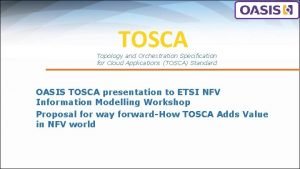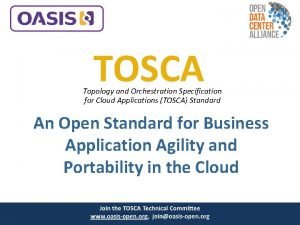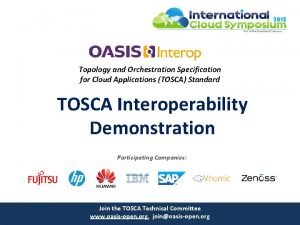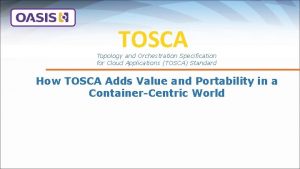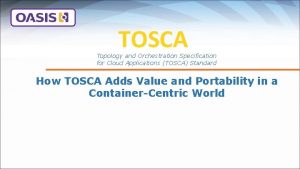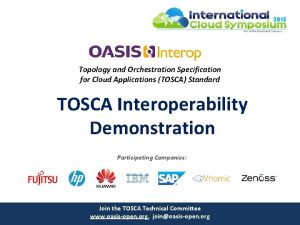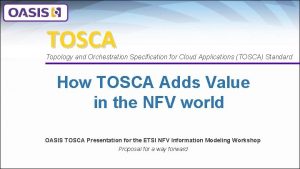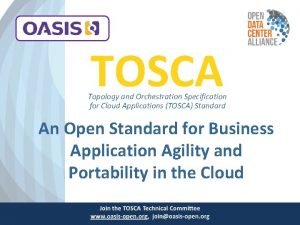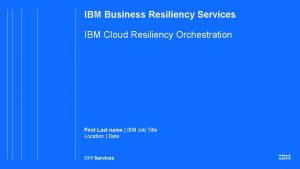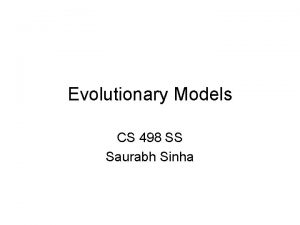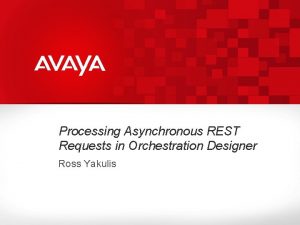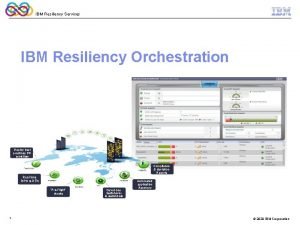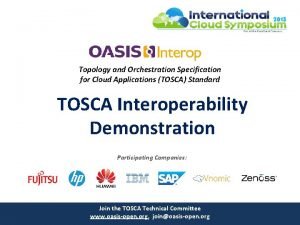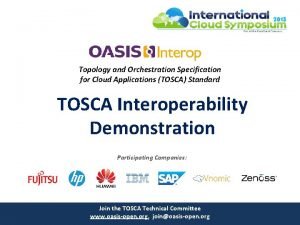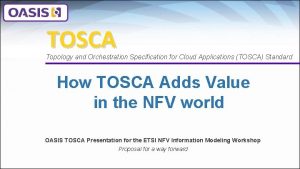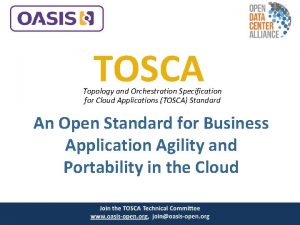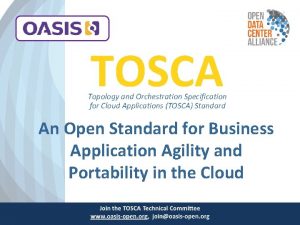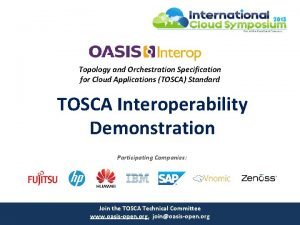Topology and Orchestration Specification for Cloud Applications TOSCA


















- Slides: 18

Topology and Orchestration Specification for Cloud Applications (TOSCA) Standard TOSCA Interoperability Demonstration Participating Companies: Join the TOSCA Technical Committee www. oasis-open. org, join@oasis-open. org

TOSCA Complete cloud application modeling and orchestration Enable portability and semi-automatic management of cloud applications across clouds regardless of provider platform or infrastructure thus expanding customer choice, improving reliability, and reducing cost and time-to-value. The TOSCA standard… provides the Interoperable Description of: Applications, their component Services and Artifacts Platform and Infrastructure services, Relationships between these services, and the Management and Operational behavior of these services facilitates higher levels of Solution Portability: Portable deployment to any cloud that can orchestrate TOSCA service templates Simplify Migration of existing customer apps. to cloud Dynamic, Flexible Scaling and bursting of multi-cloud applications Enables Software Defined Environments (SDEs) Template contents provide the means to optimize the underlying cloud infrastructure Contributing Members

Business Value of TOSCA Open Ecosystem for Cloud Services • Vendor-independent definitions of complex Cloud services provide new marketing channel for solutions in the Cloud • Decoupling of Cloud infrastructure and Cloud content helps focus on key aspects: Cloud Provider or Cloud Service Provider • Ability to deploy services in any standards-compliant environment avoids vendor lock-in and eases migration Interoperability and Composition • Goes beyond VMs in describing the cloud application‘s components and their dependencies • Composition of services defined independently by their domain experts into a higher-value service • Key enabler for open hybrid Clouds Easy Adoption of new Cloud Services • Model-driven creation of Cloud Services • Standardized deployment into various kinds of environments – from test to production, from cloud A to cloud B • Process-driven Cloud Service Lifecycle Management 3

Interoperability Demonstration Overview Demonstrating: different cloud orchestration tools from different vendors all interpreting and seamlessly running the same TOSCA service templates in the same way. Suite Flex. Frame Orchestrator Cloud Services Telco Cloud Solution TOSCA Cloud Application Marketplaces Cloud Monitoring Workload Deployer and Smart. Cloud Benefits: Using TOSCA service templates, enterprise customers can easily move their applications from one cloud to another and orchestrate them using the expert knowledge the application developers have built into them.

Interoperability Demonstration Overview – “Public TOSCA Interop. Demo” 1 2 3 4 5 Vnomic’s Service Designer Tool • Models the TOSCA Interop. Demo App: • 2 -Tier Sugar. CRM App, My. SQL Database 1 Export of Sugar. CRM Application as TOSCA CSAR file • Format: Cloud Service Archive (CSAR) file • Export to a Cloud Marketplace or “App. Store” of TOSCA Modeled Applications and Services Service Designer 2 3 TOSCA “Cloud Marketplace” • Customers can rapidly discover and implement cloud solutions from TOSCA Service Templates ISM Cloud Marketplace Download / Import of Sugar. CRM to choice of: • Runtime Interop. - TOSCA-enabled clouds for seamless deployment <or> • Tooling Interop. - TOSCA-enabled tools that can alter TOSCA Service Template models View Sugar. CRM in Cloud of Choice • Companies provide 3 minute video of Sugar. CRM in their tools or deployed to clouds • Companies can opt to show more if they desire and if asked to by press or analysts. Note: Companies can choose to work with SAP (in advance) to demonstrate a SAP CRM model for private interop. events. 4 4 Pitched HP Product Teams 8/5; Expecting comeback Others TBD IBM Workload Deployer (IWD) + IBM Smart. Cloud Huawei Cloud Fujitsu Flex. Frame

Composing a TOSCA Service Template for a “Sugar. CRM” Application using Vnomic’s Service Designer, www. vnomic. com The Sugar. CRM application include 2 “Tiers”: • Web Application Tier (Linux, Apache, PHP, Sugar. CRM) • Database Tier (Linux, My. SQL) 6

The Cloud Application is made “Portable” and packaged using TOSCA’s Cloud Service Archive (CSAR) format which encapsulates the Application Architect’s “Expert Knowledge” for this demo, we choose to publish the “Sugar. CRM” Cloud Application to IBM’s Integrated Service Mgmt. (ISM) Cloud Marketplace 7

Showing “Sugar. CRM” as a newly published service by Vnomic into IBM’s “Cloud Marketplace” TOSCA service templates could be published and shared on both public and private marketplaces Demonstrating the vision of an “Open Ecosystem” of cloud services based upon TOSCA standardized service templates 8

The “Sugar. CRM” Application’s Topology Template Viewed in IWD Web Server Tier (left), Database Tier (right) … developers can choose to edit the components’ properties or simply use the defaults settings packaged in the CSAR file prior to deployment 9

The “Sugar. CRM” TOSCA Application is Fully Deployed and Running using IBM Smart. Cloud Foundation Services … we can see that both the Web Server and Database Tiers are running and assigned Public IP Addresses 10

Login to “Sugar. CRM” application running on an IBM Cloud Demonstrating Seamless TOSCA “Run-time” Portability … using the IP Address allocated by IBM’s Cloud for the Apache Web Server which was part of the Web Server Tier of the TOSCA “Sugar. CRM” application 11

More on TOSCA Modeling…

Modeling Topologies with TOSCA Service Topologies are described using the TOSCA “Meta-model”: Nodes § Represent Components of an application or service and their Properties. Example nodes include: – Infrastructure: Compute, Network, Storage, etc. – Platform: OS, VM, DB, Web Server, etc. – Granular: functional Libraries, Modules, etc. § Include Operations which are the management functions for the node – e. g. deploy(), start(), stop(), connect(), etc. § Export their dependencies on other nodes as Requirement and Capabilities Artifacts § Describe Installables and Executables required to instantiate and manage a service. Currently, they include: § Implementation Artifacts: – Executables or Plans that implement a Node’s or Relationship’s Operations (e. g. a Bash script) § Deployment Artifacts: – Installables of the components (e. g. a TAR file) Relationships § Represent the logical Relationships between nodes – e. g. “hosted. On”, “connects. To”, etc. § Describes the valid Source and Target nodes they are designed to couple – e. g. source “web application” node is designed to “connect. To” a target “database” node § Have their own Properties and Constraints Service Templates § Group the nodes and relationships that make up a service’s topology – Allowing modeling of sub-topologies § Service Templates “look like nodes” enabling: § Composition of applications from one or more service templates § Substitution of abstract Node types with available service templates of the same type A service’s Topology Model is included in a TOSCA Service Template which is packaged and shared, along with all dependent artifacts, as a TOSCA Cloud Service Archive (CSAR)

TOSCA service templates can model any cloud application or infrastructure pattern TOSCA Service Templates Application Patterns • on either Paa. S, Iaa. S platforms app db • Generalized, Normative Types Paa. S Layer Iaa. S Layer network Platform and Infrastructure Resources (using Heat Engine) Compute 2, compute scalable Network 2 Heat Engine CFN / HOT storage single Network 1 App. Resource Relationships compute Compute 1, • Derived, Custom Types Composition Layer Software Defined Environments Infrastructure Patterns • Open. Stack is one example Business Application Layer Service Oriented Applications Storage “Backplane” Drivers HW / Provider Specific Optimized Workloads Hardware Value: enables rapid and continuous delivery of diverse set of workloads with agility and optimization on programmable heterogeneous infrastructure leveraging reusable building blocks

TOSCA Service Templates support … Complete Topology Modeling Allow developers to describe the topology of their applications and encapsulate their expert knowledge, including service configurations, policies and dependencies. Full Lifecycle Orchestration Go beyond simple deployment; services can provide instructions for any lifecycle operations enabling precise orchestration and control of application management tasks. Service Composability Supports the ability to substitute logical parts of applications through composable service templates providing choice in both service vendor and implementation.

Primer Scenarios: Developing a “Single-Tier My. SQL Database” Containment Nodes can “Host” or contain other Nodes of specified types Nodes can export the types of nodes they are “capable” of hosting, These are matched to other nodes that export their specific host container “requirements” In this example: A My. SQL Database node is “hosted. On” a “My. SQL Database Management System (DMBS) node The My. SQL DBMS node, in turn, is “hosted. On” a “Linux. OS”, and so on… My. SQLDatabase hosted. On My. SQL DBMS Component “Containment” Relationship Type hosted. On My. Sql. Linux. OS Operating System hosted. On My. Sql. VM Server hosted. On DBTier “Tier” is a topological concept used to describe sets of nodes (or sub-topologies) that can be deployed and managed as a single group

Primer Scenarios: “Two-Tier Sugar. CRM Web Application” PHPModule Apache Module In this example: The “DB Tier” components are packaged into a separate service template permitting Substitution Apache Web. Server Sugar. CRM Database My. SQL DBMS hosted. On These are matched to nodes that export they are “capable” of accepting specific connections The Sugar. CRM Application node “connects. To” a database node in another “tier” hosted. On Connects. To Web Application Nodes can “Connect” to other specified node types Nodes export the types of nodes they require “require” connectivity to, DBTier Service Template Sugar. CRMApp Depends. On hosted. On Connectivity Apache. Linux. OS My. Sql. Linux. OS Operating System hosted. On Apache. VM Network “Connectivity” Relationship Type Server My. Sql. VM Server hosted. On DBTier Web. Tier Components grouped into composable service templates. Tier

Advanced Scenarios: “Scalable Sugar. CRM Web Application” Scalability Web. Tier Service Template Apache. LB “Tier” Node Types convey scalability Load. Balancer DBTier Service Template Sugar. CRMApp Sugar. CRM Database Web Application The “Web Application Tier” is declared Scalable with upper bounds “n” instances Database Apache My. SQL § Note: the “Database Tier” remains a Web. Server DBMS A Load Balancer node is added to the previous template to route requests among “Web Application Tier” instances Apache. Linux. OS My. Sql. Linux. OS Operating System single instance Both tiers are packaged into their own service templates permitting Substitution The range of instances would be a property of the “Tier” Node Type Components grouped into composable service templates. 1. . n Apache. VM My. Sql. VM Server Web. Tier Scalable. Tier 1 DBTier
 Tosca topology
Tosca topology Tosca cloud orchestration
Tosca cloud orchestration Tosca cloud orchestration
Tosca cloud orchestration Tosca cloud orchestration
Tosca cloud orchestration Tosca orchestration
Tosca orchestration Tosca orchestration
Tosca orchestration Tacker openstack
Tacker openstack Tosca orchestration
Tosca orchestration Hp cloud orchestration
Hp cloud orchestration Cloud resiliency orchestration
Cloud resiliency orchestration If lclp is negative number, we set the lclp = 0. why?
If lclp is negative number, we set the lclp = 0. why? Upper specification limit and lower specification limit
Upper specification limit and lower specification limit Cloud computing network topology
Cloud computing network topology Cs 498 cloud computing applications
Cs 498 cloud computing applications Orchestration designer
Orchestration designer Multi domain service orchestration
Multi domain service orchestration Broadband services bbs
Broadband services bbs Orchestration is about codifying tasks
Orchestration is about codifying tasks Ibm resiliency orchestration
Ibm resiliency orchestration
